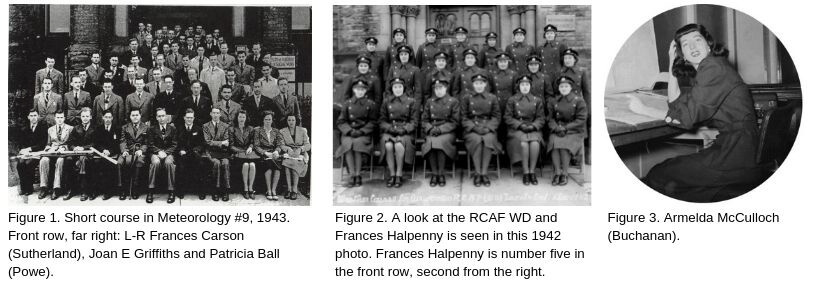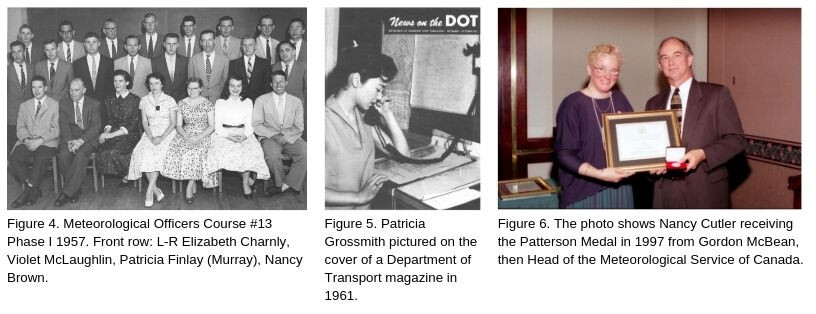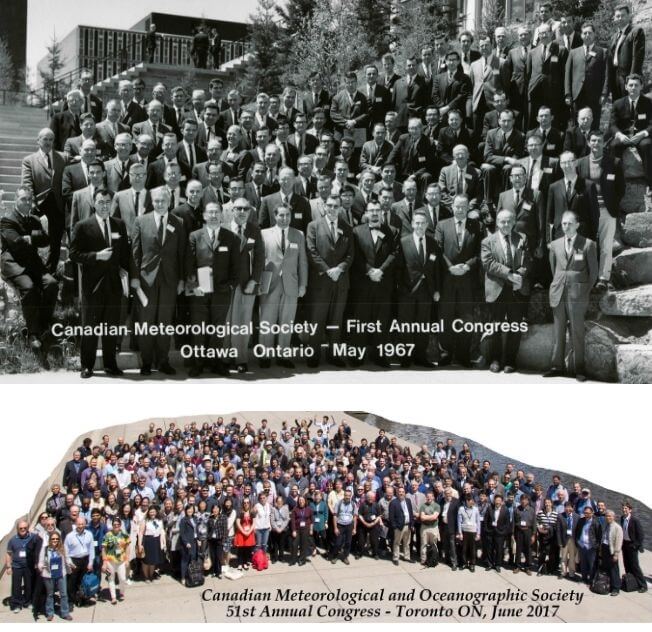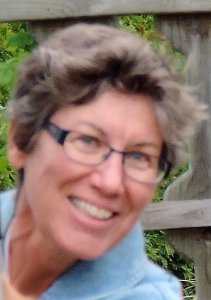
Les femmes en météorologie au Canada : les premières années
– par Rebecca Milo –
En 2017, la Société canadienne de météorologie et d’océanographie (SCMO) a célébré son 50e anniversaire. Ce jalon a poussé la Société à jeter un regard sur l’arrivée des femmes dans le domaine de la météorologie. Leur histoire est liée à l’avancement des femmes sur le marché du travail et à leur accession à un statut d’égales au travail.
L’arrivée des femmes au sein de la profession de météorologiste commence vers le début de la Seconde Guerre mondiale, lorsque l’étude de la météorologie devient une priorité en temps de guerre.
En 1938-1939, le Canada accepte d’assumer une grande partie du Plan d’entraînement aérien du Commonwealth britannique (PEACB). Toutes les bases de formation au Canada nécessitent alors des services météorologiques. La Division de la météorologie du ministère des Transports embauche des centaines de diplômés universitaires et les forme comme officiers en météorologie au sein de l’Aviation royale du Canada (ARC). Au départ, les recrues sont toutes des hommes.
Pendant une bonne partie de la guerre, la météorologie reste une profession au contingent presque entièrement masculin. Pour appuyer l’effort de guerre, quelques femmes possédant les compétences requises sont embauchées pour répondre à la demande croissante d’officiers en météorologie. En 1943, les trois premières femmes diplômées de l’université participent à un cours d’introduction en météorologie. Les photographies de ces trois pionnières, ainsi que de celles qui les ont suivies, sont tirées des archives de la SCMO. Elles illustrent cet article et racontent l’histoire des premières femmes à accéder à la profession de météorologiste.
In 2017, the Canadian Meteorological and Oceanographic Society (CMOS) celebrated its 50th anniversary. Spurred by that, CMOS decided to look back at the early days of women in meteorology. Their history is tied to the advancement of women in the workforce and their achievement of equal status in the workplace. With regard to gender equality in general, it was only the 1929 decision of the Judicial Council of Britain’s Privy Council, Canada’s highest court at the time, when women were legally recognized as “persons” under British common law.
Women’s involvement in the profession of meteorology had its beginnings near the start of World War II when the study of meteorology became a wartime priority. When men were called up to serve in the Canadian Armed Forces, women replaced them in many fields including meteorology.
Canada had been building its meteorological capability for observing and forecasting during the late 1930s recognizing the need for improved aviation weather services, primarily for civil aviation. By 1938, aviation services had become a major component of the newly formed Meteorological Division in the Department of Transport. The Meteorological Division was led by John Patterson and housed at the University of Toronto. Patterson was a well-known physicist and because of this was able to work with the university to develop post-graduate courses in meteorology in an effort to meet the new demand.
With the outbreak of war, the demand for meteorological services increased exponentially. Not only did the Meteorological Division have to provide support to the Canadian Armed Forces in addition to civil aviation, but in 1938/39 Canada made a decision that would have a tremendous impact on the Meteorological Division in terms of increased demand. Canada agreed to take on a major portion of the British Commonwealth Air Training Plan (BCATP). All the training bases in Canada, which reached 100 by the end of the war, required meteorological support. In response, the Department of Transport’s Meteorological Division hired hundreds of university graduates and trained them to serve as Meteorological Officers within the Royal Canadian Air Force (RCAF). Initially these hires were all male, most without post-graduate degrees, and in some cases only limited mathematics and physics courses. Nonetheless, following a “Short Course in Meteorology” given at the University of Toronto they were hired as Meteorological Assistants Grade 3 or dependent forecasters and were deployed to various military bases and became known as metmen within the military environment. Some went on to take an advanced meteorology course offered by the University of Toronto and became meteorologists or independent forecasters even though these courses were not at the post-graduate level, which had been a non-wartime requirement.
Well into the war, meteorology remained an almost completely male profession. It appears that no thought was given to hiring women into the Meteorological Division until about 1943. About a year earlier, the RCAF had formed a Women’s Division (WD) to meet the need for observers and plotters, for which a university degree was not required. The WD comprised in-uniform members of the RCAF and they were the pioneer Meteorological Technicians. The success of this program may have influenced Patterson to hire a few qualified women to fill the growing demand for Meteorological Officers to support the war effort. Or it may have simply been the fact that qualified men were in scarce supply. In any event, the Short Course in Meteorology #9 in 1943 included three female university graduates. As were their male counterparts, these women were hired on a temporary basis because the wheels of government bureaucracy turned too slowly to meet the demand. This meant that they were given no assurances of ongoing employment when the war ended. In 1941 the salary for Meteorological Assistant Grade 3 was $1620.00 which was substantially less than non-flying officers within the RCAF.
The three women on course #9 were Frances Carson (Sutherland), Joan E. Griffiths, and Patricia Ball (Powe) (figure 1). Joan Griffiths and Frances Carson did well enough on the Short Course in Meteorology to be chosen to go on to the advanced course given by the University of Toronto that took place during the winter of 1943/44.
Frances Carson was posted to the Moncton District Aviation Forecast Office (DAFO). She married another meteorologist, Con Sutherland, and resigned in 1945. Patricia Ball married Norm Powe, an experienced observer, who was also at the Moncton DAFO. She resigned, never having worked in a meteorological office. Joan Griffith was posted (1944/45) to Jericho Beach, Vancouver, which was the Western Command Headquarters for the RCAF and went on to have a long career that included directing the training of the WD for a period.
These initial three were followed by two women who completed short course #10 (1943/44). One of these, Joan O’Brien, was believed to have had the longest career of the first five women. She was posted to Winnipeg and remained there for 27 years. Her obituary notes that she provided excellent support as the Administrative Assistant and Technical Advisor to the Officer-in-Charge. Her classmate, Mary (Mona) Pirie (Ninnes), worked at Meteorological Division Headquarters at 315 Bloor Street in Toronto before resigning to raise a family. She returned to the Meteorological Service some years later to work in informatics and retired around 1980. Ms. Ninnes passed away March 20, 2019 at the age of 101.
Although, as noted earlier, these first five women graduates were generally assigned to civilian meteorological sections or DAFOs, other women were engaged in meteorology with the RCAF as part of the RCAF’s WD (figure 2). Many of these women assisted the metmen at their meteorological stations, and around 1942 these airwomen began to replace metmen as observers and map plotters. One of these women, Frances Halpenny, who was on the WD course #5 worked as an observer during the war but returned to her pre-war employer, the University of Toronto Press, and went on to become the Associate Director from 1979 to 1984. She was named an Officer of the Order of Canada in 1979 and Companion in 1984 among many other honours. Ms. Halpenny died in 2018 at the age of 98.

Following the war, many metmen, including many of the women, left the Meteorological Division because the number of bases had been significantly reduced, and the demand for services dropped. Many returned to their pre-war professions, such as teaching, and many of the married women decided to remain at home and raise their families. It is interesting to note that of the approximately 125 meteorologists (advanced course or master’s degree graduates) who were trained in wartime, 90 or so remained for their entire career. Of the 220 metmen (and women) trained, only about 110 remained employed in the weather service at the end of the war. Two of the women who trained under these wartime programs, Joan Griffith and Joan O’Brien, spent their careers in the field and could certainly be called trailblazers.
Although the Meteorological Service was reduced in numbers after the war, John Patterson felt that world events might lead to another war and, therefore, expected the need for another expansion of the Meteorological Service in the future. Following his retirement in 1946, John Patterson made a number of recommendations on how to address an increased requirement. One of these recommendations was “Women had proved to be competent and should be employed wherever possible and given the same opportunity for training as men.”
Despite this endorsement, with limited hiring after the war, the next time a new graduate female employee is encountered is in 1949, when the first female to obtain a master’s degree in meteorology joined the Division.
Armelda McCulloch (Buchanan) worked in the Moncton DAFO (seen in figure 3 on the forecast desk) and was married in 1950.
In the sixties, Armelda, or Melda as she was known, returned to the Comox Valley and became involved in political and environmental issues. Her first love was always nature, and it became her passion in life to protect the natural paradise in which she lived. To that end she co-founded the Comox Valley Society for the Prevention of Cruelty to Animals (SPCA), helped fund the North Island Wildlife Centre, became involved in the creation and expansion of Sealbay Park (a commemorative plaque in her name can now be seen there), and supported the protection of the Macdonald Woods in Comox. She participated in the blockade at Strathcona Park, later becoming a board member and financial supporter, to ensure the maximum protection of the park lands. Before her death in 2004, Melda made a significant bequest to The Land Conservancy of British Columbia. Melda did not make meteorology her career, but her legacy was environmental activism.
In the following year (1950) after Melda’s graduation, three more women participated in the master’s course, however little is known of their careers. They were Fran Dawes, Lillian M Dunn later Flint) and Gloria Logan (Ellenton).
As far as we can tell, no other women were hired as meteorologists until 1957 when four women, Violet McLaughlin, Patricia Finlay (Murray), Nancy Brown, and Elizabeth Charnly attended meteorology course #13. We see them here (figure 4) in the class photo, Meteorological Officers Course #13 Phase I 1957.
However, as Pat Finlay Murray recalls:
“…by the time I was married in 1962, I was the only one left and I resigned to have a baby. Then I …… decided to try and get back into the Weather Service. I ran into a problem as they still wouldn’t accept women, but by that time we had some equal rights legislation and I was hired for the weather office in Winnipeg. Anyway, to make a long story short, I spent the next 30 years in the Winnipeg Weather Office and retired in 1992.”
This not only highlights the difficulty in retaining women after the war but also the challenges facing women leaving and then wishing to return to the workplace after raising children.
About 10 years after the first female master’s program graduate, Patricia Grossmith (Gladis) joined the Meteorological Service. She obtained her degree on the 1960 master’s course but left in 1962 to pursue a career in the field of physics of liquid crystals. Despite her brief meteorological career she became a poster girl for the Department of Transport, which highlighted an unusual phenomenon — a “weather women” on the cover of their magazine in 1961 (figure 5). Ms. Grossmith is another example of a women trained in meteorology who went on to achieve remarkable success and make a name for herself in another field. She held various professorships and research positions and went on to work in Paris for three years. There, she conducted research at the University of Paris (Orsay) in her field of specialty, the physics of liquid crystals. During that time she worked with the Orsay Liquid Crystal Group, whose founder, Professor Pierre-Gilles de Gennes, won the Nobel Prize in physics in 1991 for his work on liquid crystals and polymers.

After her research position in Paris, she worked at Bell Labs as a research physicist to continue her work on liquid crystals. She held various positions and professorships and received several awards during her career including the Edith Kreeger Wolf Distinguished Professor award, an endowment given by the Gender and Sexuality Studies department of Northwestern University to recognize women who have made major contributions to their fields. She was appointed a fellow of the American Physical Society in 1983 and later received a Guggenheim Fellowship in 1993. She also received the Humboldt Prize, an award that “recognizes lifetime achievements and facilitates international scientific collaboration.”
Had she stayed in meteorology, Patricia would undoubtedly have won the Patterson Medal among other awards.
Speaking of the Patterson Medal (the highest award for Canadians in distinguished service to meteorology), Nancy Cutler is the first and only woman to win this award in its 63 years of existence (figure 6).
The first woman to obtain a PhD in meteorology was Marianne English (née Weiss) who attended McGill after graduating from the master’s course in 1964. In that year she was quoted in the Winnipeg Free Press saying,
“…her chosen field of meteorology is a good one for women. There are few women in Canada in the field and there will be a need for more and more.”
Following her PhD, Dr. Weiss worked for the Alberta Research Council in their work on hailstorms and rainfall, as well as with the Clean Air Strategic Alliance (CASA). Later she worked in many parts of the world including Denver Colorado, Johannesburg South Africa, and London England.

Although the history of women in meteorology started some 80 years ago, even as late as 1967, the field was still dominated by men. That year the attendees at the Canadian Meteorological Society (CMS) Congress were all male, as illustrated in the photo of about 100 delegates (top photo, figure 7).
The 51st CMOS Anniversary Congress, held in Toronto in 2017, tells a different story, with many women participating and serving in roles such as session chairs (bottom photo, figure 7).
Readers of electronic versions of this article may zoom the following photo to several hundred percent to see the many women now participating. The CMOS Archivist was consulted and kindly did the numbers, based on those who came for the 2017 photo. The total number of delegates was 245 of which 81 were women!
Although we cannot positively identify the first female meteorologist in Canada, in the first 20 years of women in meteorology in Canada, there were a number, as mentioned above, who were trailblazers for the many women who followed. The careers of many of these women were rather brief because they left to pursue other endeavours or decided to resign and raise families. Things began to change in the 1970s when the number of women in the Meteorological Service increased significantly, in step with an increase in hiring throughout the Public Service and the recognition that women can raise a family and have a career.
During subsequent years there were many firsts for women in the Meteorological Service. For example, in the early 1970s Doris Quinn was the first female to be posted to the Arctic. Carol Klaponski was the first woman to serve on a Canadian Military base, and Mary Regan the first women to serve overseas in uniform with the RCAF. Before this there had been some apprehension about unchaperoned single women working the graveyard shift in such locations. During that period, there was also a dress code for women. Skirts were not allowed to be short, and more than one woman was denied access to the Officers Mess when wearing the newly introduced pant suit. Needless to say, these ideas changed substantially in the following decades.
In more recent times, women trained in meteorology have made the most of opportunities and been promoted to senior positions within the Meteorological Service, as well as in other science-based departments. These achievements bode well for current and future women graduates of the meteorology programs and for the organizations employing them.
Despite the advances made in recent years, women remain less likely to choose a career in Science, Technology, Engineering, and Mathematics. This stands in contrast to many other fields of study, in which women now represent the majority of graduates. We can see from the makeup of our intake programs over the last decade or so that our recruitment of women is not yet 50%, but women are increasingly represented.
In conclusion, two of the trailblazing women who joined during the war years went on to have a full career in meteorology. In the following years, we had our first female with a master’s degree in meteorology and ten years later, for the first time, a woman obtained a PhD in meteorology. Although these women were clearly pioneers in their own way, the women entering the field during the 1970s also led the way for the many women to follow. They all contributed to the current state of meteorology in Canada where, for the most part, men and women are now treated equally. Although many more women have ascended to the senior ranks of the Meteorological Service, and one even won the Patterson Medal, we have yet to have a female meteorologist become the Assistant Deputy Minister. There remain more goals for women to achieve.
References
1. Encyclopædia Britannica, web site. Article Persons Case, published October 11, 2018. Retrieved from https://www.britannica.com/event/Persons-Case
2. Morley Thomas, Metmen in Wartime, Meteorology in Canada 1939–1945 (pp. 309–310). 2001. Toronto: ECW Press.
3. Morley Thomas, Metmen in Wartime, Meteorology in Canada 1939–1945 (p. 48). 2001. Toronto: ECW Press.
4. Morley Thomas, Metmen in Wartime, Meteorology in Canada 1939–1945 (p. 310). 2001. Toronto: ECW Press.
5. Morley Thomas, Metmen in Wartime, Meteorology in Canada 1939–1945 (p. 316). 2001. Toronto: ECW Press.
6. P. Finlay, email to R. Jones, October 9, 2017
7. City’s Rainy Days Earn Woman Degree. (July 9, 1964) Winnipeg Free Press (p. 16).
Pictures courtesy CMOS archives:
Fig 1. Short course in Meteorology #9 1943, Frances Carson (Sutherland), Joan E Griffiths and Patricia Ball (Powe)
Fig 2. Armelda (Melda) McCulloch (Buchanan) on the desk in the Moncton DAFO, 1949
Fig 3. Weather Course for RCAF Airwomen (WD), 1942
Fig 4. Meteorological Officer Course #13 Phase I, Elizabeth Charnly, Violet McLaughlin, Patricia Finlay (Murray), and Nancy Brown
Fig 5. Pat Grossmith on the cover of the Department of Transport magazine, “News on the DOT” 1961
Fig 6. Patterson Medal, Nancy Cutler and Gordon McBean
Fig 7. CMS Congress 1967 and CMOS Congress 2017

About the Author
Rebecca (Becky) Milo is a retired meteorologist living in Ottawa. She has been an active CMOS member since 1981, including serving as Chair of the Ottawa Centre in 1993.
More Like This: